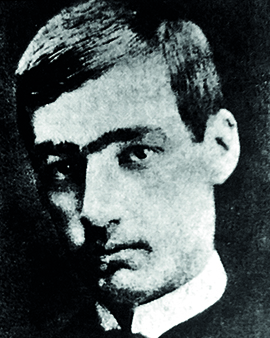Joseph Crawhall counts among the British nature painters. He was born in the middle of the 19th century in the Northwest of England and spent most of his life on the island. Joseph Crawhall III, his full name, was born into a family with an artistic tradition. His drawing talent was encouraged and promoted by his parents. On the paternal line, an artistic sideline had been pursued for several generations as a semi-professional leisure activity. His father sold watercolour paintings, but his main occupation was antique dealer, writer and rope maker. In the course of his childhood he saw that his father, Joseph Crawhall II, possessed many talents and successfully turned them into financial success.
The further development to a painter he experienced during a three-year study at King's College in London. There he was able to refine his technique to such an extent that he received a recommendation from a lecturer for a study visit to Aimé Morot in Paris. When he spent a year there, he was able to experience a city that had recovered from the political turmoil of the past 90 years and was pulsating. There could hardly be a greater contrast to his home country. For his artistic development this stay was very stimulating and valuable. The pictures from the Parisian period onwards developed a deeper level of detail and density of meaning. His teacher required him to draw exclusively from memory. This was a big difference to the years of training before, because in London he drew from the original. In Paris, he also began to study Chinese and Japanese art. This was still a big fashion in the 1880s.
His journeys took him to Tangier, Morocco and Spain between 1882 and 1884. The impressions he brought back with him from his travels he was able to put even better on paper with the new Parisian memorial technique. On the recommendation of some friends he was able to become a member of the Glasgow Artists' Circle Glasgow School. This provided him with a good customer base for his financial success on the market. From the mid-1890s he moved to Yorkshire and devoted himself full-time to horse breeding. Although his work as a painter was no longer the focus of attention from this time on, he continued to produce a high frequency of paintings.
Many of his works are now on display in the museums of Glasgow and Edinburgh. Many of his works can be found in Glasgwos. Both the Glasgow Burell Collection and the Kelvingrove Art Gallery and Museum in Glasgow have works by Joseph Crawhall III.
×





.jpg)
.jpg)
.jpg)
.jpg)
_-_(MeisterDrucke-1470278).jpg)
_-_(MeisterDrucke-1470278).jpg)
_-_(MeisterDrucke-1472287).jpg)
_-_(MeisterDrucke-1472287).jpg)
_-_(MeisterDrucke-1131197).jpg)
_-_(MeisterDrucke-1131197).jpg)
_-_(MeisterDrucke-1470891).jpg)
_-_(MeisterDrucke-1470891).jpg)
_-_(MeisterDrucke-1472062).jpg)
_-_(MeisterDrucke-1472062).jpg)
 - (MeisterDrucke-77583).jpg)
 - (MeisterDrucke-77583).jpg)
_-_(MeisterDrucke-1470786).jpg)
_-_(MeisterDrucke-1470786).jpg)
_-_(MeisterDrucke-1471264).jpg)
_-_(MeisterDrucke-1471264).jpg)
.jpg)
.jpg)
.jpg)
.jpg)
.jpg)
.jpg)
_-_(MeisterDrucke-1471661).jpg)
_-_(MeisterDrucke-1471661).jpg)
_-_(MeisterDrucke-1470867).jpg)
_-_(MeisterDrucke-1470867).jpg)
_(see_also_351309)_-_(MeisterDrucke-1131198).jpg)
_(see_also_351309)_-_(MeisterDrucke-1131198).jpg)
_-_(MeisterDrucke-569365).jpg)
_-_(MeisterDrucke-569365).jpg)
_-_(MeisterDrucke-1470698).jpg)
_-_(MeisterDrucke-1470698).jpg)
_-_(MeisterDrucke-997333).jpg)
_-_(MeisterDrucke-997333).jpg)
 - (MeisterDrucke-85262).jpg)
 - (MeisterDrucke-85262).jpg)
_-_(MeisterDrucke-1471255).jpg)
_-_(MeisterDrucke-1471255).jpg)
.jpg)
.jpg)
_-_(MeisterDrucke-1473024).jpg)
_-_(MeisterDrucke-1473024).jpg)
) - (MeisterDrucke-158691).jpg)
) - (MeisterDrucke-158691).jpg)
_-_(MeisterDrucke-1472061).jpg)
_-_(MeisterDrucke-1472061).jpg)
_(see_also_351310)_-_(MeisterDrucke-1131199).jpg)
_(see_also_351310)_-_(MeisterDrucke-1131199).jpg)
_-_(MeisterDrucke-1470828).jpg)
_-_(MeisterDrucke-1470828).jpg)
_-_(MeisterDrucke-42864).jpg)
_-_(MeisterDrucke-42864).jpg)
.jpg)
.jpg)
_-_(MeisterDrucke-1471271).jpg)
_-_(MeisterDrucke-1471271).jpg)
_-_(MeisterDrucke-1473013).jpg)
_-_(MeisterDrucke-1473013).jpg)
_-_(MeisterDrucke-1473012).jpg)
_-_(MeisterDrucke-1473012).jpg)
.jpg)
.jpg)
_-_(MeisterDrucke-1472052).jpg)
_-_(MeisterDrucke-1472052).jpg)
_-_(MeisterDrucke-1473317).jpg)
_-_(MeisterDrucke-1473317).jpg)
_-_(MeisterDrucke-1472285).jpg)
_-_(MeisterDrucke-1472285).jpg)
_-_(MeisterDrucke-1472288).jpg)
_-_(MeisterDrucke-1472288).jpg)
_-_(MeisterDrucke-1470910).jpg)
_-_(MeisterDrucke-1470910).jpg)
_-_(MeisterDrucke-551728).jpg)
_-_(MeisterDrucke-551728).jpg)
_-_(MeisterDrucke-1471045).jpg)
_-_(MeisterDrucke-1471045).jpg)
_-_(MeisterDrucke-1473316).jpg)
_-_(MeisterDrucke-1473316).jpg)
_-_(MeisterDrucke-269064).jpg)
_-_(MeisterDrucke-269064).jpg)
_-_(MeisterDrucke-1470868).jpg)
_-_(MeisterDrucke-1470868).jpg)
_-_(MeisterDrucke-1470827).jpg)
_-_(MeisterDrucke-1470827).jpg)
_-_(MeisterDrucke-1472286).jpg)
_-_(MeisterDrucke-1472286).jpg)
_-_(MeisterDrucke-1472281).jpg)
_-_(MeisterDrucke-1472281).jpg)
_-_(MeisterDrucke-1123002).jpg)
_-_(MeisterDrucke-1123002).jpg)
 - (MeisterDrucke-292266).jpg)
 - (MeisterDrucke-292266).jpg)
.jpg)
.jpg)
.jpg)
.jpg)
.jpg)
.jpg)
.jpg)
.jpg)
.jpg)
.jpg)
_-_(MeisterDrucke-1472504).jpg)
_-_(MeisterDrucke-1472504).jpg)
_-_(MeisterDrucke-593947).jpg)
_-_(MeisterDrucke-593947).jpg)
_-_(MeisterDrucke-1472051).jpg)
_-_(MeisterDrucke-1472051).jpg)
_-_(MeisterDrucke-1472053).jpg)
_-_(MeisterDrucke-1472053).jpg)
 - (MeisterDrucke-180319).jpg)
 - (MeisterDrucke-180319).jpg)
.jpg)
.jpg)
_-_(MeisterDrucke-1174121).jpg)
_-_(MeisterDrucke-1174121).jpg)
_-_(MeisterDrucke-560669).jpg)
_-_(MeisterDrucke-560669).jpg)
_-_(MeisterDrucke-1471359).jpg)
_-_(MeisterDrucke-1471359).jpg)
.jpg)
.jpg)
.jpg)
.jpg)
.jpg)
.jpg)
_-_(MeisterDrucke-568872).jpg)
_-_(MeisterDrucke-568872).jpg)
_-_(MeisterDrucke-1472284).jpg)
_-_(MeisterDrucke-1472284).jpg)
_-_(MeisterDrucke-909319).jpg)
_-_(MeisterDrucke-909319).jpg)
.jpg)
.jpg)
_-_(MeisterDrucke-1470787).jpg)
_-_(MeisterDrucke-1470787).jpg)






